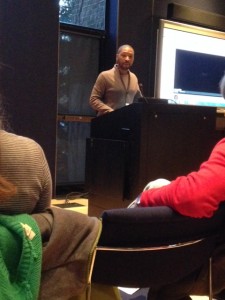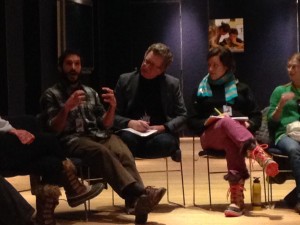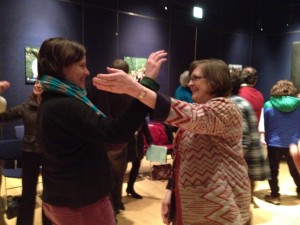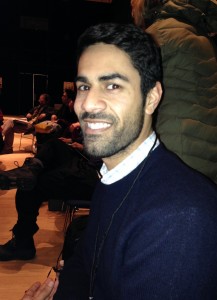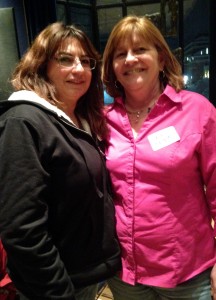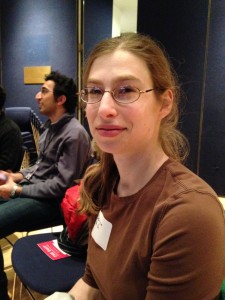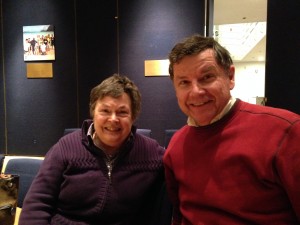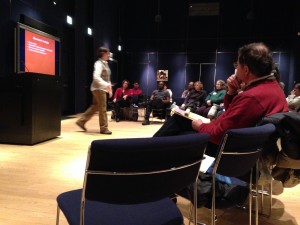UMS Night School: Bodies in Motion – Session 8 Recap
Editor’s note: This post is a part of a series of by U-M student Sarah Squillante, who’s covering our free UMS Night School: Bodies in Motion series. Learn along side with them.
UMS Night School’s 8th session welcomed the largest crowd yet. That’s not too surprising, given the notoriety and accolades of its special guest: award-winning choreographer and dancer Kyle Abraham, winner of the prestigious MacArthur Fellowship and numerous other awards. His work – a dynamic fusion of hip-hop and modern – is often laden with questions of gender, race, poverty, and politics. He is working on creating new works for his company, Abraham.In.Motion, in addition to previous works like Pavement and The Radio Show (excerpts below).
We’re excited to announce that Abraham’s company will be making its UMS debut during our 2014-2015 season (we’ll reveal the details when we launch our 2014-2015 season on April 13, 2014). After quick introductions, the entire session was dedicated to a talk and short discussion detailing Abraham’s personal dance history, influences, and recent works.
Check out some of Abraham’s previous work in the following videos, which were shown during his talk:
U-M Dance Sophomore Elizabeth Benedict (on left in photos below) was encouraged by a professor to attend on Monday night. “I liked the talk because I saw a lot of how I move in his movements [in the videos]. I was inspired because I haven’t been dancing since I was three, and he hasn’t been dancing since he was three either. It was really validating,” she said. “He was really humble about everything.”
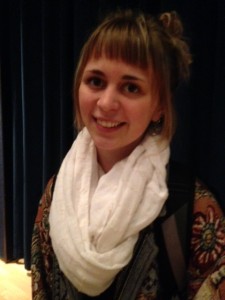
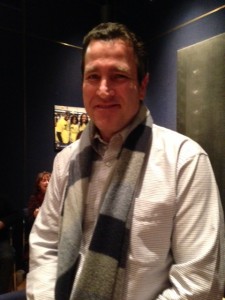
Abraham also attracted those less familiar with modern dance. “I didn’t grow up understanding dance, really,” said second-time attendee and ballroom dancer, Tom (above, on right). “I do a lot of social ballroom dancing, but I come from a music family with lots of visual art and music exposure – never dance.”
Night School is coming to a close! Join us for a recap of the semester and graduation next week, March 31, in the U-M Alumni Center at 7 PM.
Share questions, comments, or suggestions in the comments below.
UMS Night School: Bodies in Motion – Session 7 Recap
Editor’s note: This post is a part of a series covering our free UMS Night School: Bodies in Motion series. Learn along side with them.
On Monday, March 17, we focused on dance on camera, and the process of both creating dance for film and documenting dance through film. Special guests included U-M faculty members Peter Sparling (Dance) and Terri Sarris (Screen Arts & Cultures).
Download a recap of the session and related materials: UMS Bodies in Motion Session 7 – Key Theme, Players, and Definitions.
For next class
Night School continues at the same time and place on Monday, March 24 at 7 PM in the U-M Alumni Center. The next session will focus on “Making Ballet Personal” with special guest award-winning emerging choreographer Kyle Abraham. To prepare, take a look at an excerpt of his work below, and read Dance Magazine’s feature.
Additional resources
Special guest Terri Sarris also recommends:
Reines D’un Jour – directed by Pascal Magnin (selection shown during class)
Maya Deren’s Choreography for the Camera
For more of special guest Peter Sparling’s work:
Autophagy Suite (Projected onto UM Natural History Museum rotunda floor from above with 5 dancers in performance with scientist Dan Klionsky.)
Interested in even more dance engagement? Pick up an adventure card to learn all about the dance activities we’re offering this year and for a chance to win a backstage meet and greet.
Share ns, comments, or suggestions in the comments below.
UMS Night School: Bodies in Motion – Session 6 Recap
Editor’s note: This post is a part of a series of by U-M student Sarah Squillante, who’s covering our free UMS Night School: Bodies in Motion series. Learn along side with them.
“I used to dance when I was a little girl – I have very fond memories of it,” said one UMS Night School attendee. Eddie King decided to come upon a friend’s suggestion, adding that he’d “been to a bunch of performances before and had never heard this stuff.”
It’s clear that everyone is inspired to come to Night School for difference reasons, but all have one thing in common: a curiosity about body movement.
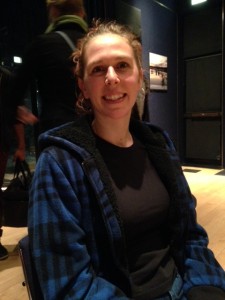
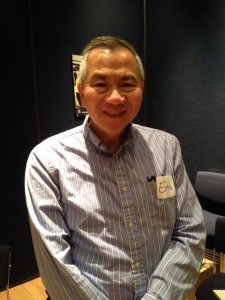
Newcomers Marly Spieser-Schneider and Eddie King share their first impressions on Night School.
On a sunny Monday night, the class was first split up into small discussion groups to tackle a few questions regarding a recent experimental performance created and performed by Jennifer Monson and DD Dorvillier. They watched a short clip from a past performance of RMW (a)/RW and brought up questions regarding intimacy, the impact of lighting, design, and music choices, audience-performer interaction, social commentary, and the strength of the dancers.
UMS director of education and community engagement Jim Leija, who served as substitute teacher in host Clare Croft’s absence, reminded attendees that it was perfectly acceptable to exit the theater and not “get it” – especially in an experimental piece like this one – even if one is a frequent dance performance patron.
Night School attendees were again treated to a panel of an array of experts – this time in the field of music. Melody Racine, U-M Associate Dean for Academic Affairs and Associate Professor of Voice, Joseph Gramley, U-M Assistant Professor of Music and Co-Coordinator of Percussion, and Conductor Yaniv Segal spoke about the movement of the body in orchestral, percussion, and vocal performances in an effort to prepare attendees for the Israel Philharmonic Orchestra on March 15.
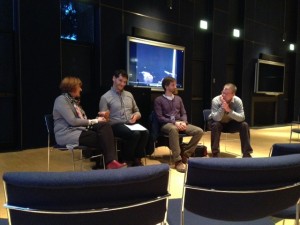
Melody Racine, Jim Leija, Yaniv Segal, and Joseph Gramley discuss body movement in music performance.
Segal began the discussion with a movement exercise intended to convey what exactly a conductor does. The discussion that followed examined the physicality of playing an instrument (and vocal performance), which included the importance of body movement and the necessity of “breath.”
Music performance doesn’t typically get people talking about movement, but attendees were enthusiastic to chat about these genres through the bodies in motion lens. “There was a lot said by the panel that I could identify with as a dancer,” said Marly Spieser – Schneider, a former U-M dance student who was new to Night School. “There’s usually a language barrier between dancers and musicians, and it was nice to hear things that really resonated with me.”
Attendee Geoff Smereck added that Night School has equipped him with a movement vocabulary that transcends performances: “One cross-cutting concept that I’m applying to all performances is harmony,” he said.
For Marly, Night School was a great experience because the discussion didn’t get stuck on one topic for too long. “The first topic could have taken an hour, but it’s good to discuss something and then move on, since some people won’t be able to connect to a particular topic.”
Night School continues at the same time and place on Monday, March 17 at 7 PM in the U-M Alumni Center. The next session – “Dance on Camera” – will focus on creating dance for film. The dance-curious are also invited to check out Gillam dance’s performance of “Sit, Kneel, Stand” at the Berman Center for the Performing Arts on March 12.
Session Resources
- UMS Bodies in Motion Session 6 – Key Theme, Players, and Definitions [Word Document assembled by Marcus White, MFA Candidate – Dance, University of Michigan]
Interested in even more dance engagement? Pick up an adventure card to learn all about the dance activities we’re offering this year and for a chance to win a backstage meet and greet.
Share questions, comments, or suggestions in the comments below.
UMS Night School: Bodies in Motion – Session 5 Recap
Editor’s note: This post is a part of a series of by U-M student Sarah Squillante, who’s covering our free UMS Night School: Bodies in Motion series. Learn along side with them.
Educationally rich. Inspiring. Moving. Authentic. Sharing. These are just a few of the many words UMS Night School attendees provided when asked to summarize their experiences thus far.
“This is making me think so much more deeply about the play,” said Sharman Spieser.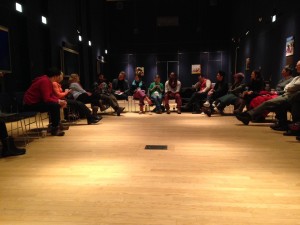
Sharman’s comment was just one among many in a discussion of Théâtre des Bouffes du Nord’s production of The Suit that opened up Monday’s session, led by U-M Professor of Theatre, Jillian Eaton.
Points of reflection concerned the transformation of the play from a short story, the significance of music, the development of the main female character, the subtlety of apartheid undertones, and, of course, movement.
“[Movement] was not a layer that was added on. It was at the core of the performance,” said one attendee.
Host Clare Croft asked attendees how they connected physically with the performance. This was a night school session devoted to Bodies in Motion, after all. Attendees were invited to share how they physically reacted to certain moments, and how they thought they would feel if they were one of the audience members pulled on stage during the audience participation moment in the performance.
“What I’ve learned the most at night school is how movement is a part of everything that you do,” said Lisa Beard.
The session moved to a discussion with this question at its center: What does it mean to experiment in motion? U-M Associate Professor Dance, Amy Chavasse, got bodies moving instead lips, this time using an exercise in which pairs of two walked toward each other, slowly writing their names in the air with a body part. The room buzzed with discussion as soon as the lines collided.
U-M Associate Professor of American Culture, Larry La Fountain-Stokes, emphasized the value in performances that break the dance mold, specifically in regard to the traditional male/female stereotype. One such performance is the upcoming RMW (a)/RW and Toe, performances by DD Dorvillier and Jennifer Monson, performances that came out of a conference called Meanings and Makings of Queer Dance Research. The shows will be performed in the U-M Duderstadt Center Video Studio on North Campus on February. 26 and 27 at 7:30 PM.
The pleasure and value of experimentation was summed up by Clare Croft, who said, “I find that the kinds of performances I like the most are those when I end up saying what’s going on? What’s going on? What’s going on? This is awesome.”
Night School is taking a short break and will resume on Monday, March 10 at 7 PM in the U-M Alumni Center. Our sixth session, entitled “Bodies Make Music,” will delve into the movement of musicians and prepare attendees for the Israel Philharmonic Orchestra.
Interested in even more dance engagement? Pick up an adventure card to learn all about the dance activities we’re offering this year and for a chance to win a backstage meet and greet.
Session Resources
- UMS Bodies in Motion Session 5 – Key Theme, Players, and Definitions [Word Document assembled by Marcus White, MFA Candidate – Dance, University of Michigan]
Share questions, comments, or suggestions in the comments below.
UMS Night School: Bodies in Motion – Session 4 Recap
Editor’s note: This post is a part of a series of by U-M student Sarah Squillante, who’s covering our free UMS Night School: Bodies in Motion series. Learn along side with them.
Does a discussion of theatre belong in a Night School series devoted to dance? Is there a place for opera, on-stage violence, even music? After Monday’s UMS Night School session, most attendees would probably say that it does.
Host Clare Croft reminded attendees that there are multiple ways to enter a performance. Even in theatre, she said, it’s useful to pay attention to movement and ask ourselves: How are performers using the space? What can we learn about the characters from how they move or stand? She introduced four speakers who offered their personal take on the upcoming performance of Théâtre des Bouffes du Nord’s production of The Suit, directed by Peter Brook.
Naomi Andre, U-M Associate Professor of Women’s Studies, explained the significance of South African opera, reminding participants of dance-like qualities of voice performance. UMS Campus Engagement Specialist, Shannon Fitzsimons, spoke about legendary theatrical director Peter Brook, and touched on his “sense of visual economy” and “commitment to emotional truth,” among other details. UMS Director of Programming, Michael Kondziolka, touched on his skepticism before seeing the performance for the first time and his reasons for selecting the piece. He noted that it is really “telling a story about the movement of bodies.” Finally, Rob Najarian, U-M Assistant Professor of Theatre and former fight/violence director, encouraged attendees to think about the “shared experience” between audience and performer. He led a movement exercise that illustrated the deliberate nature of movement.
Attendees also had a chance to reflect on the past weekend’s performances of Compagnie Kafig, demonstrating a movement that embodied the show to share with the group; many found that the troupe had an incredible amount of athleticism and humor.
One attendee noted that her experience at the You Can Dance workshop affected her viewing of Compagnie Käfig: “It wasn’t the type of move that makes you go to your friends and say, ‘wow did you see that?’ but I really noticed the intricacy and complexity in movements that seem so simple,” U-M graduate and frequent Night School attendee Sasha Kapshai said.
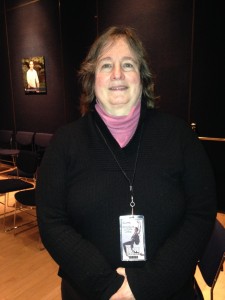
Attendee Jane Michener didn’t have plans to see The Suit before the evening, but then changed her mind. “I’m intrigued by all the intricacies of how it’s put together,” she said.
Session 5 of Night School, Body Experiments, will explore ways in which dancers experiment and create new ideas in dance, preparation for Jennifer Monson and DD Dorvillier’s RMW(a)/RMW, and discussion of The Suit. Special guests include: Anita Gonzalez, U-M Professor of Theatre and Drama, Amy Chavasse, U-M Associate Professor of Dance, Larry La Fountain-Stokes, U-M Associate Professor of American Culture, Gillian Eaton, U-M Assistant Professor of Theatre, and Rob Najarian, U-M Assistant Professor of Theatre.
The upcoming weekend is full of dance-related viewing opportunities! Check out the Dance on Camera Festival at the University of Michigan Museum of Art and the UMS performance of Théâtre des Bouffes du Nord: The Suit, 2/19-2/22 at the Power Center.
Session 4 Resources
- Excerpt from Peter Brook’s The Open Door
Interested in even more dance engagement? Pick up an adventure card to learn all about the dance activities we’re offering this year and for a chance to win a backstage meet and greet.
For a complete list of 2013-2014 dance performances, visit ums.org. Share questions, comments, or suggestions in the comments below.
UMS Night School: Bodies in Motion – Session 3 Recap
Editor’s note: This post is a part of a series of by U-M student Sarah Squillante, who’s covering our free UMS Night School: Bodies in Motion series. Learn along side with them.
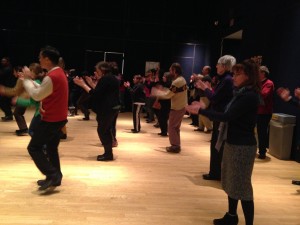
UMS Night School attendees danced to a new beat this week – literally. Midway through the session, attendees were asked to get up on their feet, learn a basic Capoeira step, and then free-style in a large circle to funk music. The movement exercise, led by U-M Dance MFA Candidate Marcus Whiten, gave attendees a kinesthetic taste of a distinct style – a mix of hip hop, martial arts, and acrobatics – that Compagnie Käfig will bring to Ann Arbor this weekend, February 14 and 15.
This week also marked the beginning of a new format in which attendees have the opportunity to discuss a recent dance performance. This week’s discussion centered around “Moving Pictures,” a concert featuring 4 works performed by the U-M department of Dance. In a short panel discussion, three dancers spoke first of the larger ideas that they were asked to conceptualize during the beginning stages of the pieces, then progressed to more specific elements of the performance, like costuming and live music. The dancers expressed delight in the challenges that the pieces provided and in the connections that they were able to make with the audience.
The attendees comprised a diverse a group as usual, ranging from experienced dancers to those who had never seen a performance before. The class has grown significantly since the first week. Some have become Night School “regulars,” while others ventured out into the cold for the first time.
In the left photo, newcomer Razi Jafri said he came because he “didn’t really know anything about dance – artistically or technically,” so he figured it’d be a good introduction.
On the right, Lucie Cohen and Deb Taylor came to Night School thinking they’d be seeing a dance performance, but were pleasantly surprised by the discussion format. “I really enjoyed getting involved when we started moving. The proximity of our bodies made me feel like I knew people on a personal level,” Lucia said.
Leslie Woldenberg, a dance lover and frequent UMS patron, drove all the way from Toledo with a friend to experience Night School for the first time.
The session finished with a short talk from Reighan Gillam, Postdoctoral research fellow in the U-M Department of Afroamerican and African Studies, who spoke about the origins of hip-hop music and dance in Brazil. Gillam emphasized the fact that rappers come from the periphery of Brazil and that, much like hip hop in the United States, the content typically revolves around the violence and system inequality characteristic of marginalized groups.
The details – and the questions they inspired – were intended to help attendees frame their viewing of Compagnie Käfig. Night School host Clare Croft suggested that attendees use information from the lecture to consider how the atmosphere in Brazil may impact the movement they see on stage.
The fourth session of Night School will include an exploration of how actors think about movement, with a preparation for Théâtre des Bouffes du Nord’s The Suit, and also a discussion of Compagnie Käfig’s Correria Agwa. Special guests will include: Naomi Andre, U-M Associate Professor of Women’s Studies, Rob Najarian, U-M Assistant Professor of Theatre, and Michael Kondziolka, UMS Director of Programming. It will be held at the U-M Alumni Center at 200 Fletcher Street at 7 PM.
Session 3 Resources & Readings
- UMS Learning Guide on Compagnie Käfig
- Performance prep reading on Capoeira – “Headspin” by Barbara Browning
- Bodies in Motion Session 3 – Key Themes, Players, and Definitions [Word Document assembled by Marcus White, MFA Candidate – Dance, University of Michigan]
- Session 4 Prep Reading: Excerpt from Peter Brook’s The Open Door
Interested in even more dance engagement? Pick up an adventure card to learn all about the dance activities we’re offering this year and for a chance to win a backstage meet and greet.
For a complete list of 2013-2014 dance performances, visit ums.org. Share questions, comments, or suggestions in the comments below.
UMS Night School: Bodies in Motion – Session 2 Recap
Editor’s note: This post is a part of a series of by U-M student Sarah Squillante, who’s covering our free UMS Night School: Bodies in Motion series. Learn along side with them.
What is dance? A rhythmic movement? Deliberately choreographed steps? Expression through time and space? What makes someone a good dancer?
This week’s UMS Night School session, held on Monday night, attempted to answer these tough questions and sparked a litany of others. It also welcomed its first guest speaker: U-M associate professor of Movement Science in the School of Kinesiology, Melissa Gross. Gross spoke about her research regarding the relationship between emotion and movement. Her area of study has focuses on mostly pedestrian movements, which have been found to correlate strongly with emotion. “Your emotions impact your body movement and your body movement can impact your emotions, too,” Gross said.
Attendees were invited to conceptualize movement a bit more scientifically, but this invitation quickly inspired questions that carried over to the dance world: How do we account for cultural differences in movement? Are certain people more in tune to others’ emotions (as expressed through movement) than others?
UMS Night School host, Clare Croft (assistant professor of dance at U-M), reminded everyone that this notion can be found everywhere in dance – Martha Graham’s work, for instance, was focused on the idea of translating emotion through motion in a universally accessible way.
Rebecca Rebhuhn (photo left), a U-M Graduate Student in mathematics, was a newcomer: “There aren’t many dance events in Ann Arbor, so I go to all that I can. I used to study dance academically and figured this could be interesting,” she said. Others were back for their second week.
Attendees Susan and Geoff Smereck (photo right) have seen numerous UMS dance performances together. They describe themselves as being “exuberant about dance. “Focusing on movement like we have allows me to not focus so much on the lack of a story line,” said Susan. “[Night School is] prying my brain open and giving me ways of thinking about movement.” Geoff wasn’t surprised by the thought-provoking nature of the evening’s discussions. “This is so U of M,” he said. “I’m looking for the vocabulary to conceptualize the dance performances that I see.”
PhD student Payam Mirghams and U-M graduate Sasha Kapshai share what inspired them to come to Night School.
The session, which was held the day after the Super Bowl, ended with a fitting video of former U-M quarterback Denard Robinson in action. Attendees were asked to describe the movement of football, and then to consider what we could learn from a culture or an idea through this movement.
Night School host Clare Croft demonstrates differences in movement.
Next week’s Night School, “Technique, Virtuosity, and Monsters,” will include a discussion of Moving Pictures, the upcoming U-M Department of Dance performance, and an introduction into hip-hop – just in time for Compagnie Käfig’s Correria Agwa on February 14 and 15. Special guests will include Reighan Gillam, a Postdoctoral research fellow in the U-M department of Afroamerican and African studies, and several U-M Dance Graduate Students. It will once again be held at the U-M Alumni Center at 200 Fletcher Street.
Session 2 Resources for Download
Session 3 prep reading on Capoeira – “Headspin” by Barbara Browning
Session 2 Powepoint Presentation by U-M Assistant Professor of Dance Clare Croft
Interested in even more dance engagement? Pick up an adventure card to learn all about the dance activities we’re offering this year and for a chance to win a backstage meet and greet.
For a complete list of 2013-2014 dance performances, visit ums.org. Share questions, comments, or suggestions in the comments below.
UMS Night School: Bodies in Motion – Session 1 Recap
Editor’s note: This post is a part of a series of by U-M student Sarah Squillante, who’s covering our free UMS Night School: Bodies in Motion series. Learn along side with them.
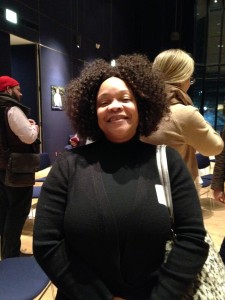
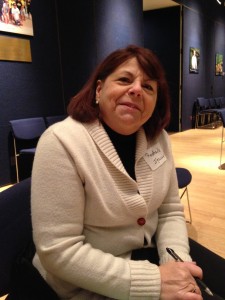
Lisa Beard (Left) and Rochelle Igrison (Right) are both enthusiastic to expand their dance knowledge.
UMS Night School isn’t designed to be a dance class, but the first session got people moving just enough to start to think differently about movement. Community members of all ages and backgrounds stood in a semi-circle in the chilly University of Michigan Alumni Center on Monday night, introducing themselves not just with names but an accompanying gestures.
Clare Croft, assistant professor of dance at the University of Michigan who’ll lead Night School this season, asked what the exercise made everyone think of and what images came to mind when they heard the word “dance.”
One attendee noticed that when the participants were asked to omit their names from the introduction, the gestures were a lot easier to understand and remember, and another suggested that movements can “characterize people and carry meaning.”
Jim Leija, director of education and community engagement with UMS, welcomed participants and said that Night School is an opportunity to “improve our comfort level with dance and make room for a reflective moment.” He emphasized that the program would not be a lecture series, but rather an interactive experience. The first session didn’t disappoint. Participants stretched out their arms in various ways and explored the ways in which even simple movement – like rubbing hands together – can be executed in many ways. Many were eager to suggest topics that they hoped to address in the coming weeks, like why we prefer certain performances over others and how dance evokes political messages.
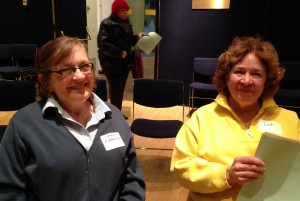
Pat Bantle (Right) is a return night-school student. “I love dance,” she said. “I came last year and I enjoyed it very much.”
Some of the participants seemed excited to engage with a medium that they already love. Lisa Beard drove all the way from Oak Park to participate. “I just turned 50 and I promised myself I’d do things I’d never done before,” she said. A longtime patron of the arts, Beard is excited to meet new people. Rochelle Igrison explained that she’s been to all of the UMS dance performances thus far. “I may not have a dancer’s body, but I can still be a patron of the arts,” she said. “I just love dance.”
Others were more explicit in what they hoped Night School would do for their engagement with the arts. Art, a frequent UMS concert goer, said he was eager to expand his dance vocabulary in order to engage in conversations after performances. “I want to be able to talk about it,” he said.
Croft showed a series of videos that touched on a breadth of dance styles and considerations, from Martha Graham’s Lamentations to a video from the 2008 Beijing Olympics. She suggested, in her parting thoughts, that participants use the sessions not only to “define what dance is, but what it does.”
Next week’s Night School, “Moving Pictures,” will welcome a U-M professor of Movement Science and a professor of Art and Design. It will again be held at the U-M Alumni Center at 200 Fletcher Street. Interested in even more dance engagement? Pick up an adventure card to learn all about the dance activities we’re offering this year and for a chance to win a backstage meet and greet!
Download Sesssion 1 Resources, including key concepts, videos, and vocabulary from the first session [Word Document assembled by Marcus White, MFA Candidate – Dance, University of Michigan]: Bodies in Motion Session 1 Key Themes, Players, and Definitions
For a complete list of 2013-2014 dance performances, visit ums.org. Share questions, comments, or suggestions in the comments below.


